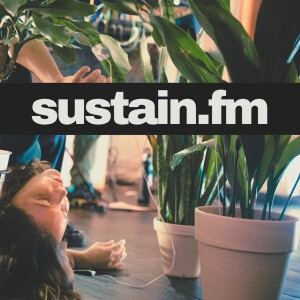
In the 1950s, Charles Keeling started measuring carbon dioxide concentrations in the atmosphere at the Moana Loa Observatory in Hawaii. These measurements showed for the first time how the planet itself is breathing as forests in the Northern hemisphere grow leaves in the Spring absorbing CO2, then release it back into the atmosphere in the Fall when leaves drop off the trees. In this episode we talk about ‘Can you hear the Earth breathing?’ a composition and performance translates this climate data into sound, that brings to life these sustainability cycles and the natural (and un-natural) systems that lie beneath the production and absorption of carbon dioxide. The performance includes both sonified data representing CO2 concentration along with field recordings, modular synthesizers, samplers, biofeedback pads connected to plants, FX pedals, and looping feedback. We talk with Lisa the data artist on the project as well as Erbse, a movement artist collaborating on the project and discuss data sonification, translating sustainability concepts and data for audiences, creating space for improvisation, decentering the human, and more.
Performance videos
First solo performance at ACUD Macht Neu, Berlin School of Sound, Berlin 2022
First performance with Erbse at ACUD Macht Neu, Berlin Modular Society, Berlin April 2023
Second performance with Erbse at Liebig12, Berlin with sustain.berlin October 2023 https://youtu.be/r3zS9dDX-Gg?si=C-7zxidcaXmD4WgH
Links and references
Lisa Knolle - https://www.instagram.com/lisas_learnings/
Erbse - https://www.instagram.com/ochjoa/
‘Can you hear the Earth breathing?’ background https://www.drusnoise.com/can-you-hear-the-earth-breathing
Sustain.fm research https://www.sustain.fm/research
CO2 data used in ‘Can you hear the Earth breathing?’:
D. Keeling, S. C. Piper, R. B. Bacastow, M. Wahlen, T. P. Whorf, M. Heimann, and H. A. Meijer, “Exchanges of atmospheric CO2 and 13CO2 with the terrestrial biosphere and oceans from 1978 to 2000”. I. Global aspects, SIO Reference Series, No. 01-06, Scripps Institution of Oceanography, San Diego, 88 pages, 2001
https://keelingcurve.ucsd.edu/
More on data sonification
Å, Stjerna, Before Sound: Transversal Processes in Site-Specific Sonic Practice, University of Gothenburg. Faculty of Fine, Applied and Performing Arts, 2018.
Hermann, T., Hunt, A., and Neuhoff, J.G. (2011). The Sonification Handbook. Logos Publishing House, Berlin. Download free PDF at https://sonification.de/handbook/download/TheSonificationHandbook-HermannHuntNeuhoff-2011.pdf
Williams, S. (2022). Can you hear the Earth breathing? Translation and disclosure in sound art data sonification in Pauletto, S., Delle Monche, S., and Selfridge, R. 2nd Conference on the Sonification of Health and Environmental Data (SoniHED 2022, pp. 44-48). https://www.dropbox.com/scl/fi/bwgn58sl6iggymksxo41u/Williams_SoniHED.pdf?rlkey=05ragquau26wova3ucn7vzqzy&dl=0
Kudos to Tim Wedde who created the py_midicsv library that we used https://github.com/timwedde/py_midicsv
New Materialism: https://newmaterialism.eu/almanac/a/agency.html
Alexis Shotwell: Against Purity. Living Ethically in Compromised Times (2016)
Jane Bennett: Vibrant Matter. A political ecology of things (2010)
Further reading:
Petra Kuppers: Eco Soma. Pain and Joy in Speculative Performance Encounters (2022)
Anna Tsing: The Mushroom at the End of the World: On the Possibility of Life in Capitalist Ruins (2015)
No comments yet. Be the first to say something!